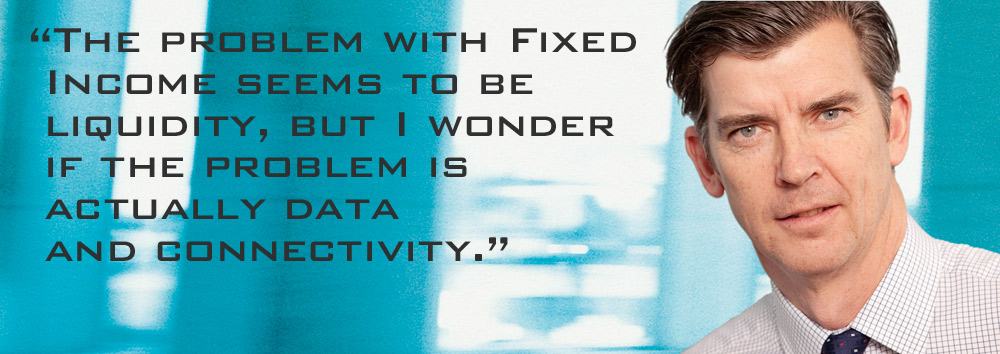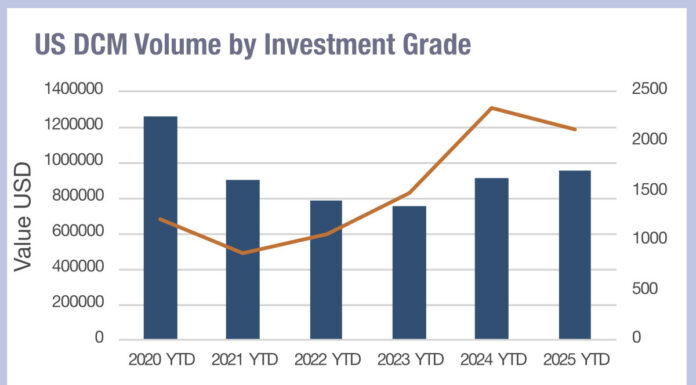By Paul Reynolds, CEO of Bondcube
For a long time I have thought that the bond market shares many dynamics with the grocery industry. Large, national franchises, some global, offering a dizzying array of products from all over the world to a vast number of people with millions of transactions.
What spiked my curiosity was how much data the large grocery firms collected about their customers and how they used that data to drive their business growth and profitability. As I watched a thousand or more customer inquiries pop up on my trading system every day I wondered what my particular bank did with that information and whether it was used in a similar way to the grocery stores.

The sad truth was, very little of that data was used at all, except for what my well-trained memory could withhold. That was perhaps acceptable when liquidity, risk appetite and balance sheet were abundant, but since 2009 I was convinced this data could be very valuable in helping my bond trading business become more efficient in matching buyers with sellers, reducing risk, increasing turnover, improving profit margins and competitiveness.
It quickly became clear to me that trying to persuade a large, traditional organisation to consider a business practice from another industry was unlikely to be a productive use of my time and probably more of a disruptive irritation for them. What I have discovered from setting up my own business was that even I was somewhat out of date with my thinking as well.
The Tesco Clubcard was in fact introduced in 1995, the same year as eBay was founded. Compare the growth of these two enterprises and you can see how wrong I was about the relevance of the grocery market. The on-line market is far more relevant, especially to Fixed Income.
The problem with Fixed Income seems to be liquidity, but I wonder if the problem is actually data and connectivity. Over the last twenty years of bond trading at major banks I have noticed a huge growth in the number of clients, number of issues, number of inquiries and size of trades. For example in 1995 I could effectively price and trade a hundred client inquiries per day, all by phone or intercom. The input required to reach execution was the same for a 10k trade or 10m. That severely constrained the profitability of the business and did not offer any potential for efficiency gains.
In 2000 it became possible to trade Fixed Income over Bloomberg. My daily turnover increased to three hundred trades a day, profitability, market share and efficiency all increased commensurately.
One curious outcome was that the sales force thought e-trading would presage the end of their careers. Surprisingly their sales credits soared in line with the increased turnover and the sales credits kept coming even when they were on holiday.
In the last fifteen years various iterations and innovations have occurred refining the convention of investors seeking liquidity from dealers. Volumes have grown dramatically, especially in smaller sizes and the more liquid issues as this is where dealer liquidity is most abundant.
Liquidity in the rest of the market has dried up completely with something like 90% of all outstanding bonds trading less than once a day. These bond issues look like the boats left marooned in the Aral Sea after 90% of it dried up.
Dealers cannot be entirely blamed for this as it is just too expensive to warehouse these bonds, but as I mentioned before, in my view dealers could be significantly more efficient at storing the data to create the matches without the need for warehousing. Herein lies the opportunity to use data to improve the probability of matching.
Some dealers are addressing the issue with their own proprietary systems or off the shelf products. The only weakness here is that if all banks have their own systems the fragmentation continues as the banks do not network those systems amongst each other.
Someone recently described the chances of a simultaneous match of buyer and seller occurring is the same as two people firing pistols at each other and expecting to survive because the bullets collided.
There is certainly some truth to this as I was frequently aware that my bank had the buyer and one of my competitors had the seller and even if we found each other in the inter-dealer market we would vehemently defend our profitability in a game of bad tempered poker, whilst both clients were left hanging.
When I compare those behaviours to what I see on eBay I am not surprised that liquidity and volume are so poor. The Fixed Income market infrastructure looks like it was designed to prevent trading, not encourage it. Some of that is due to the transition from abundant liquidity to very little and some is due to the vested interests of dealers and platforms.
When there is a fundamental change in cost structure and regulation there is usually a consequent change in behaviour. Think of the impact of low-cost airlines on travel since EasyJet was founded in 1995. We are seeing that now, especially in the number of new trading platforms. I think the winners will be the ones who successfully improve the investor to dealer model, of which there are many and the others who see a step change in model and functionality by using data and networking.
I see a time very soon when anyone can enter a bond identifier into a free website, see the price, recent market volume, the number of other interested parties, number of buy and sell interests and related securities. From there an interaction can occur with anyone on the website to exchange information, negotiate and trade. This kind of model will even inform the user of new inquiries in securities in their universe without them having to sift through vast amounts of unwanted data. The system will deliver liquidity to them and it will be real and actionable.
While 1995 was clearly a very productive year for new business ideas, I have a feeling 2015 might turn out to be just as significant as well, especially in Fixed Income.
©TheDESK 2015
©Markets Media Europe 2025












